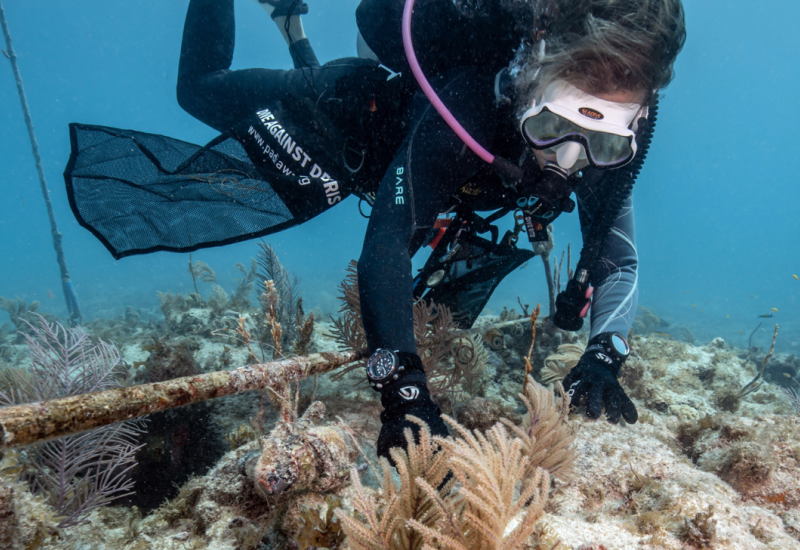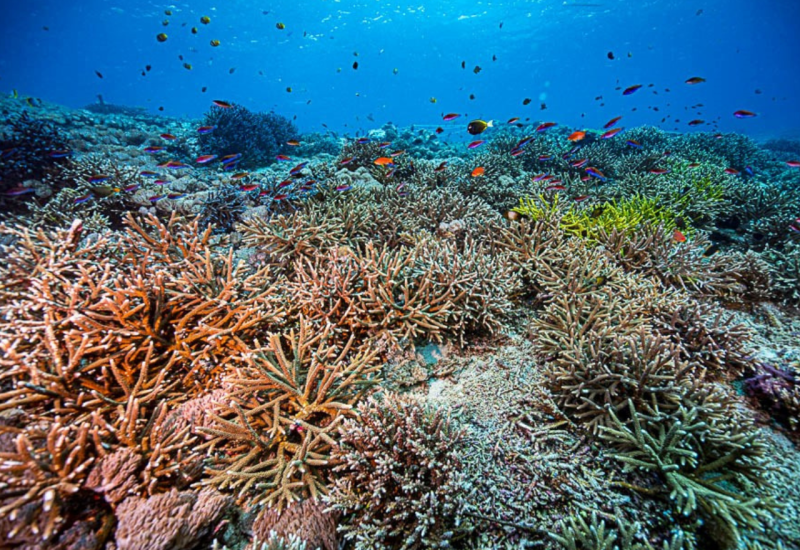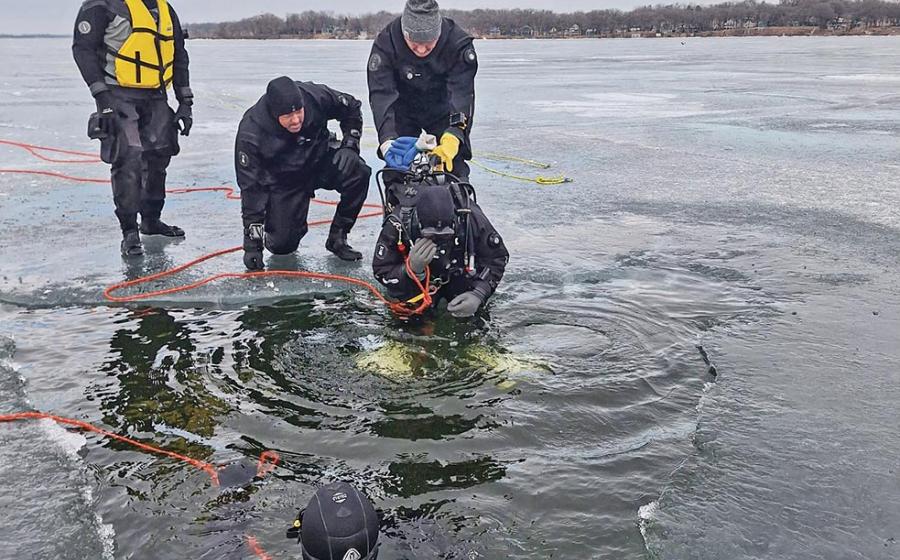Respect the Seafloor — Keep Your Bottoms off the Bottom
It’s a cardinal rule not to take anything home from the sea bottom — divers should never make mementos of living things like coral, starfish or even shells. But divers should also know better than to leave anything behind.
The Florida Keys Marine Sanctuary is asking divers not to put anything on the seafloor — even temporarily. This is becoming more and more of a problem in recent years, according to the sanctuary management. What may appear to be bare rock or uninhabited seafloor is actually teeming with life.
“From lawn ornaments to bags of candy, we’ve seen Keys divers placing or anchoring items to the seafloor, even if only long enough to take photos. Temporary placement of an item may seem innocuous, but such activities can harm the reef resources that attract divers to the Keys in the first place,” says Sean Morton, sanctuary superintendent.
Read the full release from the Florida Keys National Marine Sanctuary below to learn more about this issue and also to learn how you can get a permit for approved seafloor activity. — Katie Lewis
**Florida Keys National Marine Sanctuary asks divers to respect the seafloor****
** Placement of items on seafloor can damage young corals, marine life
Florida Keys National Marine Sanctuary asks divers for help in protecting the coral and benthic – or sea bottom – resources of the Keys and to follow existing regulations prohibiting placement of items on, or disturbance to, the sanctuary seafloor. In recent years, sanctuary management has documented an increase in activities that impact the seafloor, including the temporary placement of items for photo opportunities or marketing events.
Since 1997, the seafloor has been protected by sanctuary regulations. Approved exceptions to these regulations include anchoring in waters greater than 40 feet deep, licensed fishing gear (lobster and stone crab traps), and any other activities conducted under a valid permit from the sanctuary.
“From lawn ornaments to bags of candy, we’ve seen Keys divers placing or anchoring items to the seafloor, even if only long enough to take photos. Temporary placement of an item may seem innocuous, but such activities can harm the reef resources that attract divers to the Keys in the first place,” said Sean Morton, sanctuary superintendent. “What may look like a rock or sand to the untrained eye is actually habitat covered with life, including juvenile coral recruits.”
The sanctuary oversees a permitting process to allow activities that would otherwise be prohibited to occur with minimal negative impact to the marine environment. Permits may be issued for research, educational, archeological, or other purposes that increase the scientific understanding or natural resource value of the sanctuary and its resources. The sanctuary issues more than 200 permits every year to private and public institutions, non-governmental organizations, and individuals.
Permit applications for research and education activities are reviewed on a first-come, first-served basis. On average, processing time for permits is 30 days, but may be longer for complicated requests or requests that include the collection of sensitive or prohibited organisms (e.g., coral species). For additional information on sanctuary permits, visit http://floridakeys.noaa.gov/permits/welcome.html.
Florida Keys National Marine Sanctuary protects 2,900 square nautical miles of critical marine habitat, including coral reef, hard bottom, sea grass meadows, mangrove communities and sand flats. NOAA and the state of Florida manage the sanctuary. Visit us online at floridakeys.noaa.gov or on Facebook at www.facebook.com/floridakeysnoaagov.
NOAA’s mission is to understand and predict changes in the Earth's environment, from the depths of the ocean to the surface of the sun, and to conserve and manage our coastal and marine resources. Join NOAA on Facebook, Twitter and our other social media channels.

..
It’s a cardinal rule not to take anything home from the sea bottom — divers should never make mementos of living things like coral, starfish or even shells. But divers should also know better than to leave anything behind.
The Florida Keys Marine Sanctuary is asking divers not to put anything on the seafloor — even temporarily. This is becoming more and more of a problem in recent years, according to the sanctuary management. What may appear to be bare rock or uninhabited seafloor is actually teeming with life.

..
“From lawn ornaments to bags of candy, we’ve seen Keys divers placing or anchoring items to the seafloor, even if only long enough to take photos. Temporary placement of an item may seem innocuous, but such activities can harm the reef resources that attract divers to the Keys in the first place,” says Sean Morton, sanctuary superintendent.

..
Read the full release from the Florida Keys National Marine Sanctuary below to learn more about this issue and also to learn how you can get a permit for approved seafloor activity. — Katie Lewis
**Florida Keys National Marine Sanctuary asks divers to respect the seafloor****
** Placement of items on seafloor can damage young corals, marine life

..
Florida Keys National Marine Sanctuary asks divers for help in protecting the coral and benthic – or sea bottom – resources of the Keys and to follow existing regulations prohibiting placement of items on, or disturbance to, the sanctuary seafloor. In recent years, sanctuary management has documented an increase in activities that impact the seafloor, including the temporary placement of items for photo opportunities or marketing events.
Since 1997, the seafloor has been protected by sanctuary regulations. Approved exceptions to these regulations include anchoring in waters greater than 40 feet deep, licensed fishing gear (lobster and stone crab traps), and any other activities conducted under a valid permit from the sanctuary.

..
“From lawn ornaments to bags of candy, we’ve seen Keys divers placing or anchoring items to the seafloor, even if only long enough to take photos. Temporary placement of an item may seem innocuous, but such activities can harm the reef resources that attract divers to the Keys in the first place,” said Sean Morton, sanctuary superintendent. “What may look like a rock or sand to the untrained eye is actually habitat covered with life, including juvenile coral recruits.”
The sanctuary oversees a permitting process to allow activities that would otherwise be prohibited to occur with minimal negative impact to the marine environment. Permits may be issued for research, educational, archeological, or other purposes that increase the scientific understanding or natural resource value of the sanctuary and its resources. The sanctuary issues more than 200 permits every year to private and public institutions, non-governmental organizations, and individuals.
Permit applications for research and education activities are reviewed on a first-come, first-served basis. On average, processing time for permits is 30 days, but may be longer for complicated requests or requests that include the collection of sensitive or prohibited organisms (e.g., coral species). For additional information on sanctuary permits, visit http://floridakeys.noaa.gov/permits/welcome.html.
Florida Keys National Marine Sanctuary protects 2,900 square nautical miles of critical marine habitat, including coral reef, hard bottom, sea grass meadows, mangrove communities and sand flats. NOAA and the state of Florida manage the sanctuary. Visit us online at floridakeys.noaa.gov or on Facebook at www.facebook.com/floridakeysnoaagov.
NOAA’s mission is to understand and predict changes in the Earth's environment, from the depths of the ocean to the surface of the sun, and to conserve and manage our coastal and marine resources. Join NOAA on Facebook, Twitter and our other social media channels.










